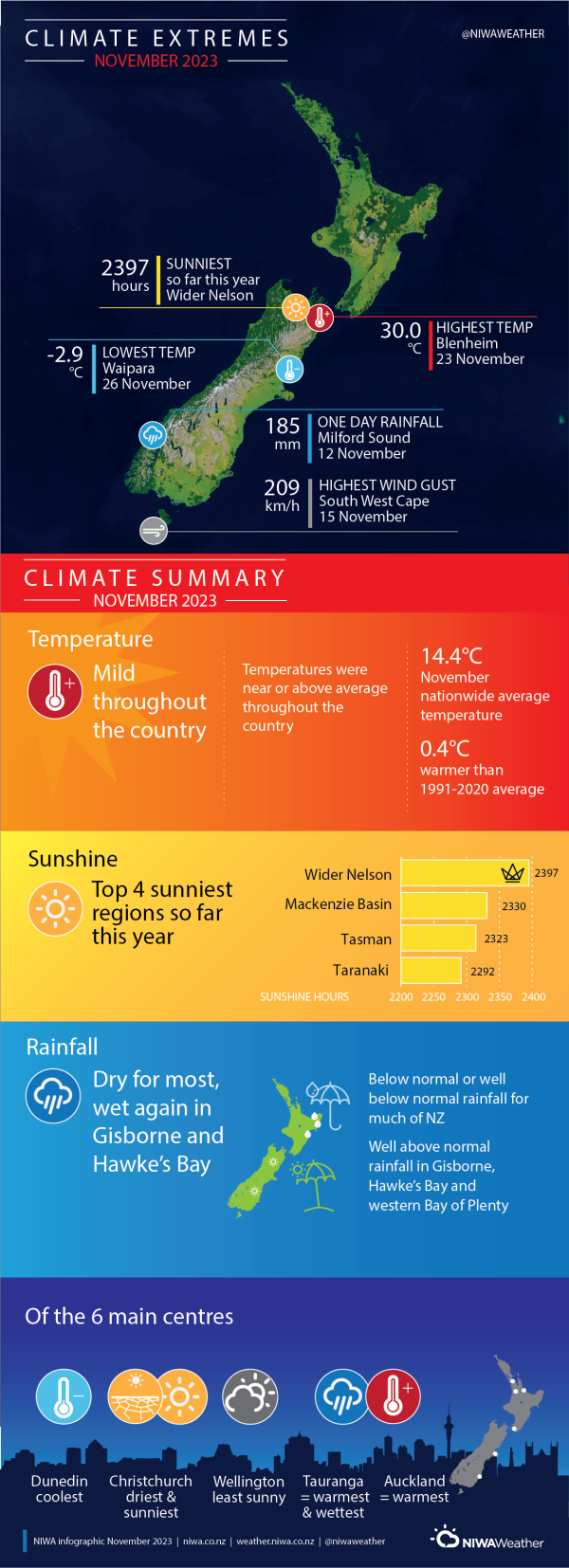Dry and mild for most, wet for Gisborne and Hawke’s Bay
|
Rainfall |
Rainfall was below normal (50-79% of normal) or well below normal (<50% of normal) for much of the South Island, the southwestern North Island, western and northern parts of Waikato, and southern parts of Northland. Rainfall was above normal (120-149% of normal) or well above normal (>149% of normal) for in western and inland parts of Bay of Plenty, southeastern Waikato, Gisborne, Hawke’s Bay, eastern Wairarapa, and parts of mid Canterbury. |
|
Temperature |
Temperatures were above average (0.51°C to 1.20°C above average) for western and inland parts of the South Island, and much of Auckland, Waikato, Bay of Plenty, East Cape, inland Whanganui, parts of Manawatū, Kāpiti Coast, and inland Wairarapa. Near average temperatures (±0.50°C of average) prevailed for most remaining areas of the country. |
|
Soil Moisture |
At the end of November, soil moisture levels were well above normal for eastern and inland parts of the North Island from western Bay of Plenty to Wairarapa, as well as the Far North. Below normal soil moisture levels were observed in western Waikato, Kāpiti Coast, Wellington, southern Canterbury, South Otago, and southern Southland. Elsewhere, near normal soil moisture levels were observed. |
Overview
November 2023 was characterised by a large belt of higher-than-normal mean sea level pressure (MSLP) that straddled Aotearoa New Zealand and the ocean to the south. This pressure setup resulted in more easterly airflows than normal, with relatively settled and dry weather for many areas (with some exceptions as described below). Rainfall was below normal (50-79% of normal) or well below normal (<50% of normal) for much of the South Island, the southwestern North Island, western and northern parts of Waikato, and southern parts of Northland. The more frequent easterly airflows brought enhanced rainfall for western and inland parts of Bay of Plenty, southeastern Waikato, Gisborne, Hawke’s Bay, eastern Wairarapa, where rainfall was above normal (120-149% of normal) or well above normal (>149% of normal). Above normal rainfall was also recorded in parts of mid Canterbury about Lincoln, Ashburton, and Methven.
Temperatures were mild across the country during November. Above average temperatures (0.51°C to 1.20°C above average) were observed in western and inland parts of the South Island, and much of Auckland, Waikato, Bay of Plenty, East Cape, inland Whanganui, parts of Manawatū, Kāpiti Coast, and inland Wairarapa. The nationwide average temperature in November 2023 was 14.1°C. This was 0.4°C above the 1991-2020 November average, making it New Zealand’s 34th-warmest November since NIWA’s seven station temperature series began in 1909.
Further highlights
- The highest November temperature was 30.0°C, observed at Blenheim on 23 November.
- The lowest November temperature was -2.9°C, observed at Waipara on 26 November.
- The highest 1-day rainfall was 185 mm, recorded at Milford Sound on 12 November.
- The highest wind gust was 209 km/h, observed at South West Cape on 15 November.
- Of the available, regularly reporting sunshine observation sites, the sunniest four regions in 2023 so far are wider Nelson (2397 hours), Mackenzie Basin (2330 hours), Tasman (2323 hours), and Taranaki (2292 hours).
- Of the six main centres in November 2023, Auckland and Tauranga were the equal-warmest, Dunedin was the coolest, Tauranga was the wettest, Christchurch was the driest and sunniest, and Wellington was the least sunny.
Download
Climate summary - November 2023 [PDF 348KB]


